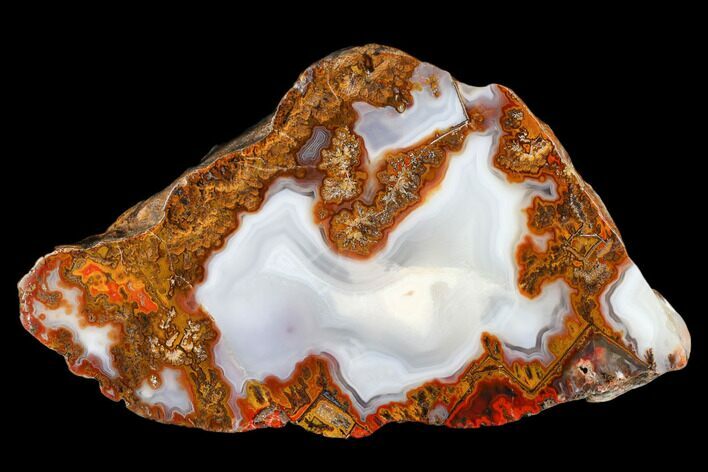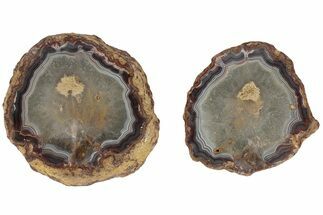This Specimen has been sold.
6.3" Colorful, Polished Agate Section - Kerrouchen, Morocco
This is a gorgeous polished agate section that was collected from the Khenifra Province of Morocco. It features yellow-orange, stalactite and plume-like formations that are encapsulated in yellow, red and white agate. Along one edge of the polished face, a strange right angle can be seen preserved within the agate. This structure is only found in geodes and agate nodules within a small area of the Moroccan Atlas Mountains. These cubic structures have been described as pseudomorphosis, meaning there was a change in substance without changing the structure, also known as a pseudomorph. However, this description is debated since fluorite, pyrite and halite are the only potential crystals that could form cubes of this size (and larger in some specimens), which is unlikely considering these crystals are formed in different geological contexts. It's suggested that moss filaments which follow a planar trend that form right angles, could be responsible for these structures. Haloquadratum walsbyi, a square-cell forming archaea, is a potential candidate for the cubic shapes in these Moroccan agates.
One side of this specimen has been cut flat and polished to a glossy finish. It comes with an acrylic display stand.
One side of this specimen has been cut flat and polished to a glossy finish. It comes with an acrylic display stand.
Banded agate nodules from Kerrouchen (also spelled Karouchen or Kerrouchene) are known for their intense red, pink, white, yellow, orange and brown agate hues. They formed as nodules from silica and iron-rich fluids within Triassic-age basaltic rock. These nodules can reach upwards of 12 inches wide and can be collected from the basalt itself. More commonly, they're collected from apple farms in the valleys where farming processes expose these nodules that erode from the basalt. Both nodular and vein/seam agates come from this region.
Agate is a variety of microcrystalline quartz (chalcedony) that displays translucence and, in some cases, banding. Agate primarily forms when silica-rich fluids fill pockets within rocks and/or fossils, depositing the silica along the walls of the rock. This process can result in banding patterns, as the compositions and impurities of these depositing fluids change over time. These banding patterns can either form as flat layers, creating linear patterns known as waterline agate, or as rounded layers, forming more common ring-like patterns. These patterns depend on the surfaces available for deposition.
Agate is a variety of microcrystalline quartz (chalcedony) that displays translucence and, in some cases, banding. Agate primarily forms when silica-rich fluids fill pockets within rocks and/or fossils, depositing the silica along the walls of the rock. This process can result in banding patterns, as the compositions and impurities of these depositing fluids change over time. These banding patterns can either form as flat layers, creating linear patterns known as waterline agate, or as rounded layers, forming more common ring-like patterns. These patterns depend on the surfaces available for deposition.
SPECIES
Chalcedony var. Agate
LOCATION
Kerrouchen, Khenifra Province, Morocco
SIZE
6.3 x 3.7", 1.5" thick
CATEGORY
SUB CATEGORY
ITEM
#181320
 Reviews
Reviews














